The Nissan Bluebird series of automobiles had a long run in Japan, from 1959 to 2001. But that nameplate was not common in the U.S. The car was sold here from 1968-73 as the Datsun 510. They offered a model that was more set up for the track known as the Bluebird SSS (Super Sport Sedan), but it was not available on our shores. This 1969 edition was probably individually imported, has right-hand drive, and has changed colors more than once. Rust and all, it’s located in McKinleyville, California, and available here on craigslist for $22,500.
In the late 1960s, Japanese auto manufacturers were getting into the U.S. subcompact space that had been pioneered by the VW Beetle. Known here then as Datsun, Nissan brought over its Bluebird 1600 and badged it as the 510. The car sold well enough for Nissan to gain a foothold which was further capitalized upon with the arrival of the successful 240Z sports car in the 1970s. Automobiles like the 510 eventually led the U.S. automakers to go small, too, with the likes of the Chevy Vega and Ford Pinto. In Japan, you could buy the SSS model which – along with independent rear suspension – came with dual Weber carburetors for the 1600cc SOHC four-cylinder engine, a more robust camshaft, and its own dashboard and steering wheel. The SSS often found its way into motorsport activities back in the homeland.
Since the SSS model was not offered in the U.S., we have to conjecture that it was brought by an individual, perhaps a serviceman who purchased the car while stationed in Japan and brought it home with him. But we don’t know how long ago that might have been. The seller calls it a “super solid example knowing what the Japan climate does,” which suggests it was in Japan longer than it’s been over here. It has rust in the rocker panels, rear quarter panels, rear floors, and probably many other places we can’t see. Lots of surface rust and flaking paint everywhere else. We assume the original color of the car was white because the interior and truck floors are white. The engine compartment is blue. And most of the rest of the car is a rather loud yellow. So, if you were going to go back to original specs with the car, I’d probably go with white.
While the car is said to be a ’69 model (we’re told these coupes were only offered from 1969-71), the dashboard purports to be from 1970. The interior appears to be in decent shape, sans any floor coverings. The seats and door panels all look to be in decent shape. We assume that if you needed parts for the car, most of what you would find for a 510 would also fit here. But how easy are those to locate? The engine appears to have been raided at some point, so you may not have everything you need to attempt to get it running again. The 4-speed manual is said to be stock.
There are no online resale values for the Bluebird SSS because they weren’t imported. But the standard 510 series can command some big bucks if you can find one in good shape. According to Hagerty, a fair condition example will set you back $6,000 while Concours cars can reach $35,000, so the condition is everything and these cars were prone to rust. Many think of the 510 as a poor man’s version of the BMW 1600/2002, which is likely why these cars command what they do. And why the seller thinks his car is so valuable. But you’ll have to put as much money into the car restoring it as you will to acquire it. So, is this really a $50,000 car when all is said and done?
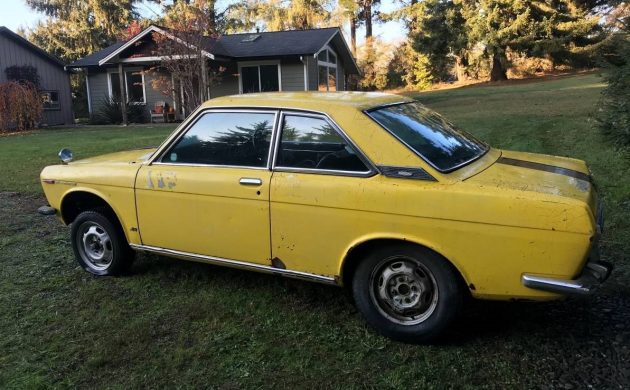
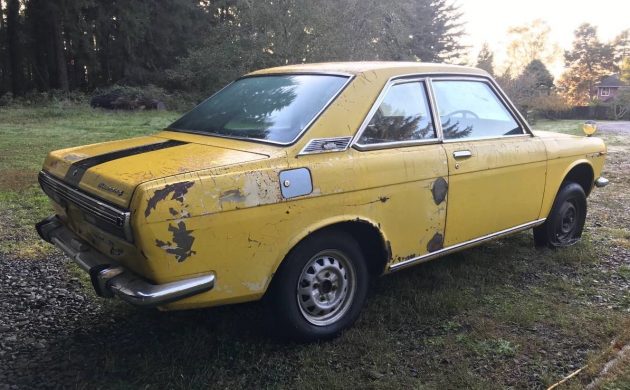
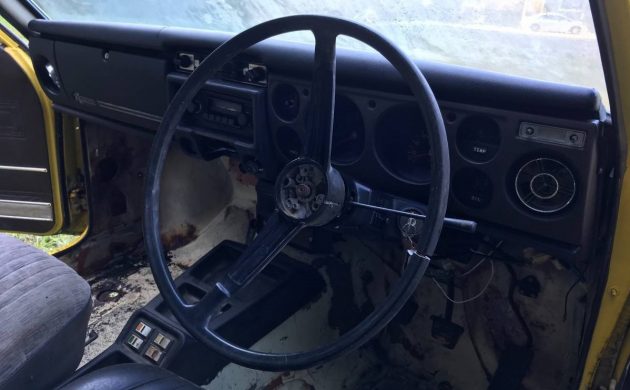
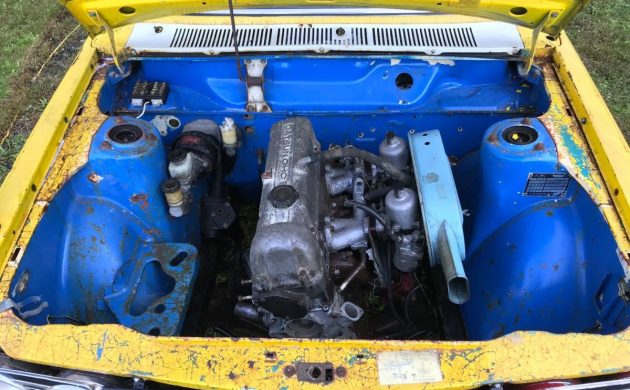
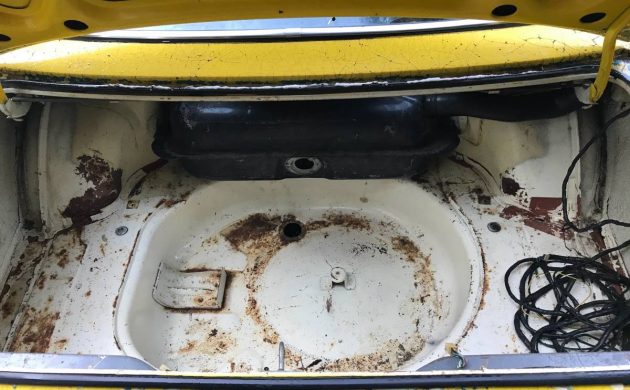


Wonder how it ever ended up there?
We used to call McKinleyville “Oklahoma-By-The-Sea”,
until all the Southern Califorians moved in & changed it.
Haha! I worked for the CDF in the late 70s out of Crescent City and that is indeed what it was called. You say the culture has evolved with recent infusions of SoCal refugees? I’m trying to picture that.
I was was a volunteer with Humboldt Fire District/-
Humboldt Bay Fire for 35 years.Lived all my life (until-
2017) there,in Eureka.Glad I got out.
There area bunch of 510 owners in the area.Used to
be a stash of about 10 of them in Willow Creek a few years
back,but got moved inland.
There was also a guy in Miranda that had a lot of them
too,but he moved some time ago.
What I remember distinctly were several Nash Metropolitan 4x4s made either by installing Jeep running gear in the Met or mounting the Met body onto a Jeep chassis. Jeepropolitans? Those were pretty cool. Somewhere in my files I have photographic proof. I’ve never seen a Met 4×4 anywhere else other than Humbolt and Del Norte Counties.
Imported 4 coupes to the US from Japan. He had 2 of them there when I went over to his house.
I know I’m not known for being overly optimistic in today’s classic car market, and here’s a prime example of why,,, you’ve simply GOT to be kidding. I’m familiar with the 510, several friends had them, they were crappy cars, I’m sorry. Paper thin doors, crummy seats, cheap plastic, no heater to speak of, it did one,,,no 2 things well, they handled good, and got great gas mileage. I went on a trip to Fla. ( from Wis.) in one, it was the worst trip ever, and I made LOTS of trips to Fla. One thing, it seems, on Barn Finds, whether their intention, or not, we see just how out of whack this hobby has become. 5 figures for this tin can, incredible.
Handled well, light weight AND responded quite well to performance tuning allowing them to dominate any class of racing they entered for years. They absolutely earned their reputation.
Remember….the car was not built with proper gauge steel…how many of these lunch boxes survived crashes? How many people in these cars were hurt?
Stu,
The gauge of steel used depended on the market country where the car was to be sold. Japanese cars made for the home market, Japan, used lighter gauge steel than cars made for the American market. I worked for a dismantler in San Francisco. Over the years we received a number of Japanese home market vehicles that somehow made it to the Port of San Francisco. They came into our possession for a variety of reasons. Some were never claimed and were abandoned on the docks. Some were caught in customs dispute and were surrendered. Some defied categorization, could not be registered for one reason or another, sat in limbo for years or decades until finally being auctioned. We always enjoyed getting these oddballs. My boss collected some because they were different and unusual.
Long story short, he bought at auction a very nice top of the line Japanese home market 1972ish Toyota Corona Mark II Coupe. It has right hand drive. It was easy to demonstrate the thinner steel. Using one hand and very little effort it is possible to deflect body panels such as the roof, trunk, hood, fenders. Not quite tin-foil but close.
This SSS is a home market vehicle and I’m a little surprised that it managed to get into the country. Regulations have surely become more stringent but I think you used to have more opportunity years ago to argue your case to the customs people if you were just bringing in one car for your own use or as a collectible. If they thought you were going to be importing them for resale you fell into an entirely different category. Isn’t that how Malcolm Bricklin got started in the Subaru business? I need to verify that.
Paolo,
Maybe My wording was incorrect. The gauge the Japanese used was not the same as here in America. I also remember applying pressure to some areas to the body of these cars and also noticed alot of movement…the metal was thin that’s for sure. This car in crashes did not do well. One of the subscribers on this site has stated his girlfriend owned one of these cars and did not survive the crash.
Howard I don’t get it either but then I do. These little cars are very much in demand. The Datsun 510’s are on fire collectability wise. This car was built for the home market. What we know is the faster cars with better tech stay in the home market. Due to the thin metal they haven’t survived well. To understand the Velocity Channel now Motor Trend had a show JDM Legends. A 510 was featured. There is tremendous interest in vintage Japanese iron. If I was a betting person I would say the guy will get strong money out of this and good for him.
Paint on the body is yellow, paint in the engine bay is blue, and paint in the trunk is white. Was this three cars welded together?
Paint on the body is yellow, paint in the engine bay is blue, and paint in the trunk is white. Was this three cars welded together?
Well, It’s a ’67, ’68, ’69, ’70, ’71, ’72’ automobile!
Why would the owner ask $22,500.00 for the heap of trash. This guy should get a doctors checkup….crap!
Three S’s because if just two, Chevy would get very angry? lol
Could be a real pain to adjust those mirrors – 1 more person/adjuster would help.
Most import tailites never intrigued me at all, unlike those on many American cars prior to ’73. But THESE intrigue me, even with the yellow/orange turn signal lens present. At least the interior seats, door panels, dash, & body panels(except for quarters, rockers, & floors) all look good.
I was engaged to a girl that drove one of these and a large truck pull out in front of her with no warning. It folded up like it was made of paper. She did not survive. This is in many ways not a safe structure to be driving in. My Europa is as bad or worse but I have the brakes and handling to avoid an accident this car does not.
Not a bad car per se but far more vulnerable than any modern car by a wide measure. I realize I have very tainted views of this machine but any future owner of one should be aware. The Japanese cars of the day were just not up to the crash protection that was available in Europe or the U.S. They are much better now.
What a terrible tragedy. I am sorry for your loss Bruce.
22k? No.
I hade one in 1968 they ran like a scalded dog got great miliage wish I had it now..but this one at the price is only 20 thousand over what it cost new.
An FYI, the SSS had a bit wilder cam and 2 Hitachi SU carburetors. Not Webers.
Nissan used Mikuni-Solex 2 barrel side draft carbs on their cars also. Not Webers.
@angliagt
Who was the car repair guy up in those parts? Motoring Monkey or something like that?
Not sure what you’re asking.Both of those stashes were
private parties.The guy in Miranda worked for Cal Trans,in
Garberville.
We didn’t have a Datsun specialty shop there.
I know. but, in the early 70s there was a shop around there named Monkey something.